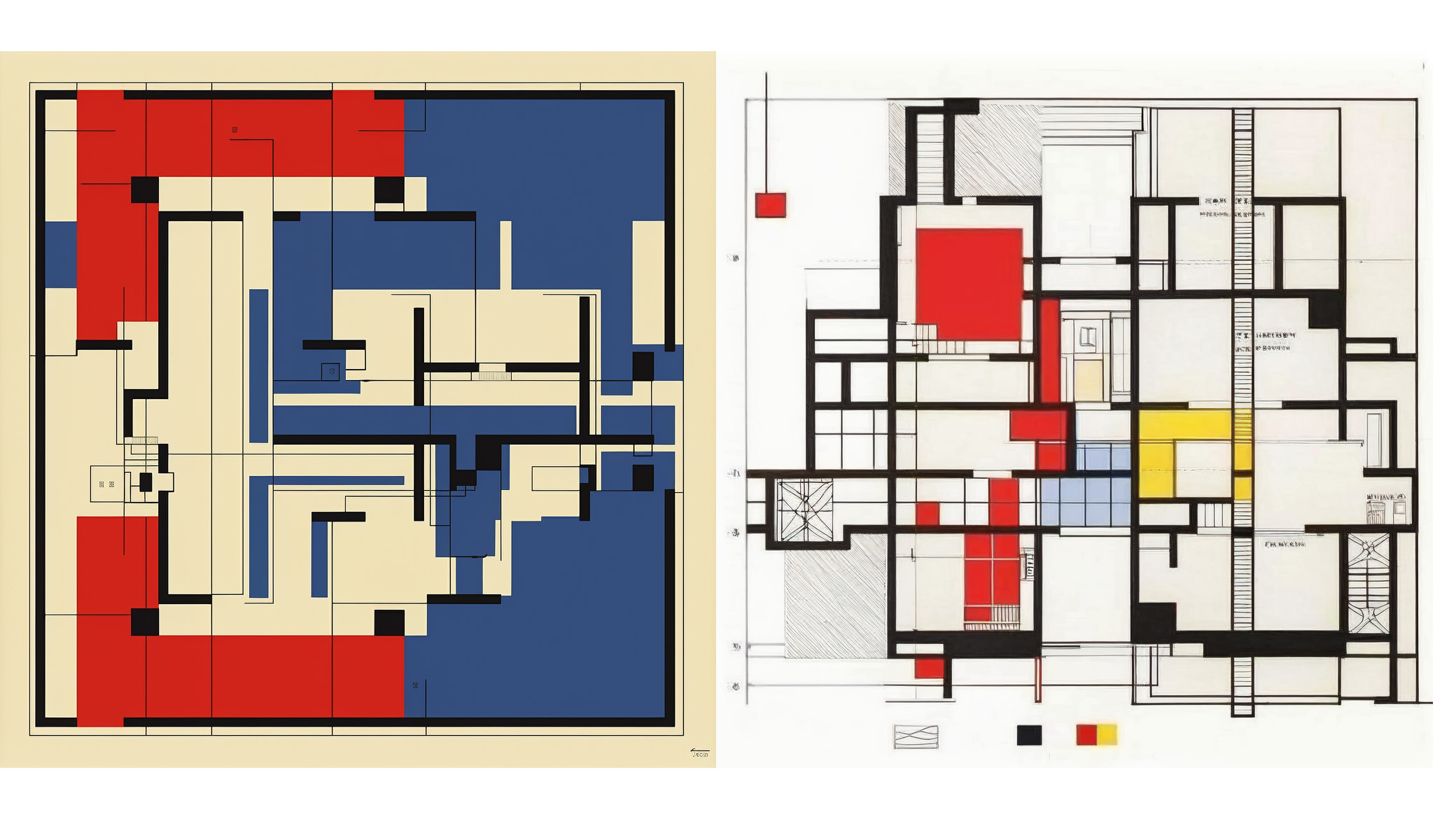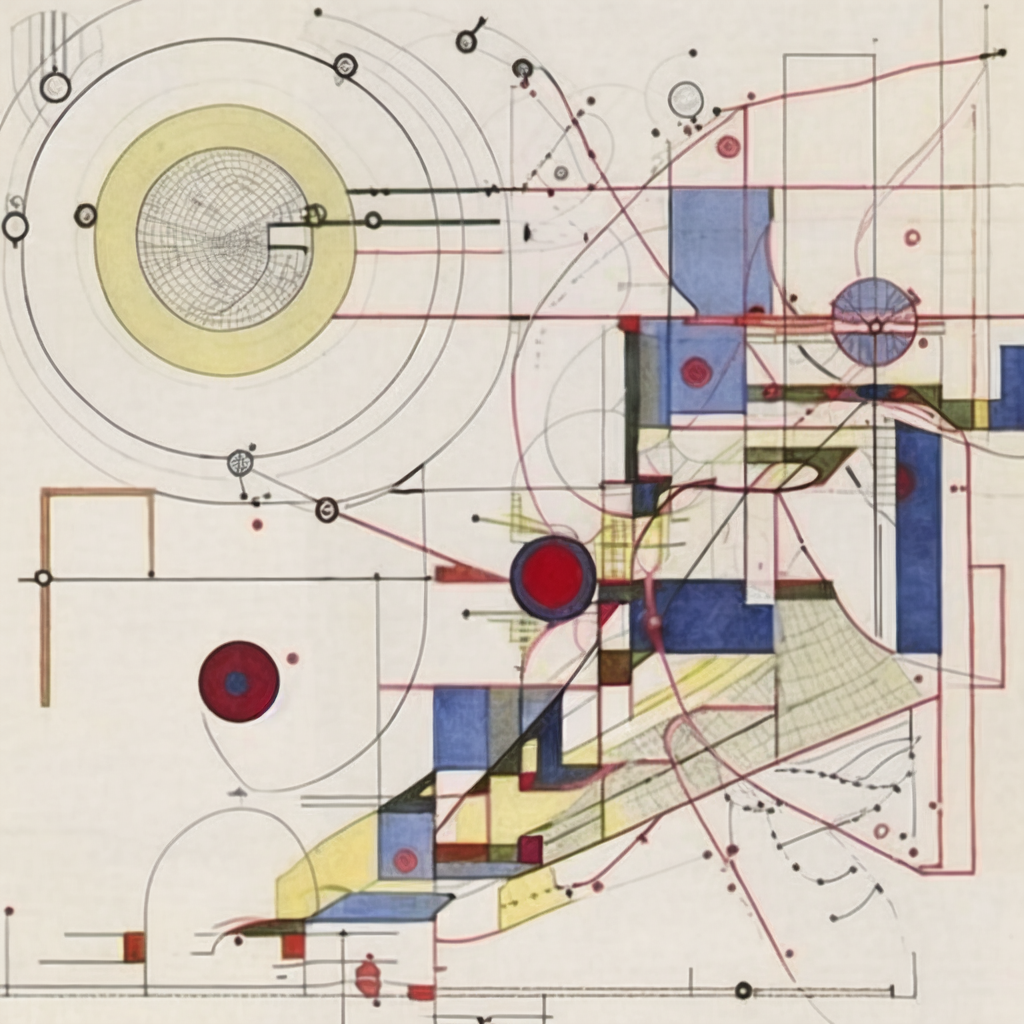︎ Architecturual Plan by Artists ︎


Date: 2023.04-2023.06
Type: Research / Individual
Tool: Midjourney & Stable Diffusion
Type: Research / Individual
Tool: Midjourney & Stable Diffusion
︎ Introduction
This project seeks to bridge the seemingly disparate worlds of fine art and architecture through the tool of generative AI. By employing advanced machine learning techniques, it aim to explore how the distinctive styles of renowned artists can be translated into inspirational architectural plans.The selected artists—Kazimir Malevich, Vasily Kandinsky, Jackson Pollock, Piet Mondrian, and Gustav Klimt—represent a diverse range of artistic movements and approaches. Their paintings, characterized by unique strokes, colors, textures, and hierarchical structures, offer a rich tapestry of visual inspiration. Through the application of generative AI, this project will analyze the compositional elements of these paintings and extract patterns that can be applied to architectural design. This process will involve translating unique artistic styles into informative architectural elements like walls, cores, windows, stairs, and other highlights of space.
Preserving artistic identity while ensuring architectural functionality readable poses a significant challenge. The ability to generate plans that are both visually compelling and easy to interpret demands meticulous adjustments to the generative AI tool.
By examining the resulting "generated plans", this project aim to uncover novel architectural possibilities and insights. The visual appearance of these plans may serve as a source of inspiration for architects, prompting them to reconsider traditional design approaches and explore new aesthetic avenues. Ultimately, this project aims to demonstrate the potential of generative AI as a tool for creative collaboration between artists and architects, fostering innovative and visually compelling architectural designs.
︎ Architectural Plan by Kazimir Malevich
The architecture plan inspired by Kazimir Malevich is characterized by its geometric forms, stark contrasts, and emphasis on purity.Geometric Forms: The plan is composed of basic geometric shapes, like squares, rectangles, and circles, arranged in a grid-like pattern. This creates a strong sense of order and simplicity. Minimalist Layout: The plan is often stripped of unnecessary details, focusing on the essential elements of the building. This creates a sense of simplicity and efficiency in circulation and programs.




︎ Architectural Plan by Vasily Kandinsky
The architecture plan inspired by Vasily Kandinsky is characterized by its abstract forms, vibrant colors, and emphasis on emotional expression. The plan features a dynamic layout and expressive lines.Abstract Forms: The plan is composed of abstract shapes arranged in a non-representational manner.
Expressive Lines: The plan features dynamic and expressive lines, creating a sense of movement and energy, could be interpreted as circulation paths and structural elements.




︎ Architectural Plan by Jackson Pollock
The Jackson Pollock-inspired architecture plan is characterized by its energetic, spontaneous lines and organic shapes. The plan's layout resembles a free-flowing, interconnected and irregular spaces.Lines: The bold, dripping lines in Pollock's paintings are reflected in the plan's winding corridors and interconnected rooms. This creates a sense of movement and dynamism.
Shapes: The organic shapes and irregular patterns found in Pollock's work are translated into the plan's unique spatial arrangements. This results in a building that is both visually interesting and challenging to navigate.




︎ Architectural Plan by Piet Mondrian
These plans presented Piet Mondrian's signature use of primary colors, black lines, and white grids is evident in the plan's layout and composition.
Colors: The primary colors, red, yellow, and blue, are used to define distinct functional areas within the building.
Lines: The black lines that outline the various spaces in the plan echo the grid-like structure commonly found in Mondrian's works. These lines serve both as structural elements and as visual dividers, creating a sense of order and clarity.
Grid: The overall grid-like organization of the plan provides a foundation for the placement of rooms and spaces, ensuring a balanced and visually pleasing composition.
Colors: The primary colors, red, yellow, and blue, are used to define distinct functional areas within the building.
Lines: The black lines that outline the various spaces in the plan echo the grid-like structure commonly found in Mondrian's works. These lines serve both as structural elements and as visual dividers, creating a sense of order and clarity.
Grid: The overall grid-like organization of the plan provides a foundation for the placement of rooms and spaces, ensuring a balanced and visually pleasing composition.




︎ Architectural Plan by Gustav Klimt
The architecture plan inspired by Gustav Klimt showcases the richness in ornamentation like his intricate paintings. The plan features intricate details, decorative elements, and a sense of opulence.Symmetry: In many local parts, the plan is symmetrical, reflecting Klimt's preference for balanced compositions, which creates a sense of harmony and order.
Decorative Elements: The plan incorporates decorative elements such as mosaics, gilding, and intricate patterns, similar in Klimt's paintings. These elements add a sense of luxury and grandeur to the building.
Natural Forms: Klimt's fascination with natural forms is evident in the plan's incorporation of organic shapes especially in stairs, floor patterns.




︎ Architectural Plan by Paul Klee
The architecture plan inspired by Paul Klee is characterized by its whimsical and playful style, resembling his colorful and imaginative paintings.Playful Shapes: The plan incorporates playful shapes, such as triangles, circles, and squares, creating possibilities for iregular rooms.
Bright Colors: The plan is filled with bright and cheerful colors, which might indicate diffrent programs in plan.




This is an ongoing project to be continued ︎︎︎ ︎